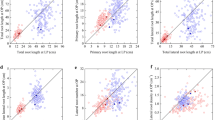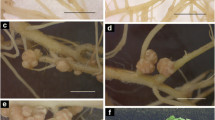Abstract
Plant root development can be largely affected through the association of roots with plant growth-promoting rhizobacteria (PGPR). However, little is known about the identity of plant genes enabling such PGPR-plant root associations. Differences in the responsiveness to PGPR among cultivars suggest genetic variation for this trait within germplasm. In this study, two genotypes of common bean (Phaseolus vulgaris L.), BAT477 and DOR364, were identified showing contrasting responsiveness in root development to inoculation with the PGPR Azospirillum brasilense Sp245. Inoculation with an A. brasilense Sp245 mutant strain strongly reduced in auxin biosynthesis or addition of increasing concentrations of exogenous auxin to the plant growth medium, indicated that the differential response to A. brasilense Sp245 among the bean genotypes is related to a differential response to the bacterial produced auxin. To further assess the role of the plant host in root responsiveness, a population of Recombinant Inbred Lines (RILs) of the DOR364×BAT477 cross was used to evaluate the efficacy of exogenous auxin on root development. We detected significant phenotypic variation among the RILs for basal root formation during germination upon addition of auxin to the growth medium. Genetic analysis revealed two quantitative trait loci (QTLs) associated with basal root responsiveness to auxin of which one explained 36% of the phenotypic variation among the RILs. This latter QTL mapped to the same location as a QTL for root tip formation at low P, suggesting that the host effect on root responsiveness to IAA interacts with specific root development. Also, significant correlations between basal root responsiveness to auxin and growth, root tips and root dry weight at low P were identified. To our knowledge, this is the first report on QTL detection for root responsiveness to auxin.





Similar content being viewed by others
References
Afanador LK, Hadley SD (1993) Adoption of a mini-prep DNA extraction method for RAPD marker analysis in common bean. Bean Improv Coop 35:10–11
Aloni R, Aloni E, Langhans M, Ullrich CI (2006) Role of cytokinin and auxin in shaping root architecture: regulating vascular differentiation, lateral root initiation, root apical dominance and root gravitropism. Ann Bot 97:883–893
Baldani VLD, Alvarez MAB, Baldani JI, Döbereiner J (1986) Establishment of inoculated Azospirillum spp. in the rhizosphere and in roots of field grown wheat and sorghum. Plant Soil 90:37–40
Barratt NM, Davies PJ (1996) Developmental and genotypic differences in the response of pea stem segments to auxin. Plant Growth Regul 19:67–76
Basten CJ, Weir BS, Zeng ZB (1999) QTL Cartographer, Version 1.13. Department of Statistics, North Carolina State University, Raleigh, NC
Beebe S, Pedraza F, Rojas M, Gutierrez J, Tohme J (1998) A genetic map of common bean combining RFLP, RAPD, SCAR, and AFLP markers. Ann Rep Bean Impr Coop 41:95–96
Benfey PN, Scheres B (2000) Root development. Curr Biol 10:813–815
Blair MW, Pedraza F, Buendia HF, Gaitan-Solis E, Beebe SE, Gepts P, Tohme J (2003) Development of a genome-wide anchored microsatellite map for common bean (Phaseolus vulgaris L.). Theor Appl Genet 107:1362–1374
Bliss FA (1985) Breeding for enhanced dinitrogen fixation potential of common bean (Phaseolus vulgaris L.). In: Ludden PW, Burris JE (eds) Nitrogen fixation and CO2 metabolism. Elsevier, Amsterdam, pp 303–310
Bliss FA (1993) Breeding common bean for improved biological nitrogen fixation. Plant Soil 152:71–79
Burdman S, Volpin H, Kigel J, Kapulnik Y, Okon Y (1996) Promotion of nod gene inducers and nodulation in common bean (Phaseolus vulgaris) roots inoculated with Azospirillum brasilense Cd. Appl Environ Microbiol 62:3030–3033
Burdman S, Kigel J, Okon Y (1997) Effects of Azospirillum brasilense on nodulation and growth of common bean (Phaseolus vulgaris L.). Soil Biol. Biochem 29:923–929
Christiansen I, Graham PH (2002) Variation in di-nitrogen fixation among Andean bean (Phaseolus vulgaris L.) genotypes grown at low and high levels of phosphorus supply. Field Crops Res 73:133–142
Churchill GA, Doerge RW (1994) Empirical threshold values for quantitative trait mapping. Genetics 138:963–971
CIAT (1996) Centro Internacional de Agricultura Tropical Annual report 1996. CIAT, Cali, Colombia
Costacurta A, Keijers V, Vanderleyden J (1994) Molecular cloning and sequence analysis of an Azospirillum brasilense indole-3-pyruvate decarboxylase gene. Mol Gen Genet 243:463–472
Dalmastri C, Chiarini L, Cantale C, Bevivino A, Tabacchioni S (1999) Soil type and maize cultivar affect the genetic diversity of maize root-associated Burkholderia cepacia populations. Microb Ecol 38:273–284
Dellaporta SL, Wood J, Hicks JB (1983) A plant DNA minipreparation: Versio II. Plant Mol Biol Rep 1:19–21
Dobbelaere S, Croonenborghs A, Thys A, Vande Broek A, Vanderleyden J (1999) Phytostimulatory effect of Azospirillum brasilense wild type and mutant strains altered in IAA production on wheat. Plant Soil 212:155–164
Dubeikovsky AN, Mordukhova EA, Kochetkov VV, Polikarpova FY, Boronin AM (1993) Growth promotion of black currant softwood cuttings by recombinant strain Pseudomonas fluorescens Bsp53A synthesizing an increased amount of indole-3-acetic acid. Soil Biol Biochem 25:1277–1281
Hetrick BAD, Wilson GWT, Cox TS (1993) Mycorrhizal dependence of modern wheat cultivars and ancestors: a synthesis. Can J Bot 71:512–518
Hetrick BAD, Wilson GWT, Gill BS, Cox TS (1995) Chromosome location of mycorrhizal responsive genes in wheat. Can J Bot 73:891–897
Jebara M, Aouania ME, Payreb H, Drevon JJ (2005) Nodule conductance varied among common bean (Phaseolus vulgaris) genotypes under phosphorus deficiency. J Plant Physiol 162:309–315
Kaeppler SM, Parke JL, Mueller SM, Senior L, Stuber C, Tracy WF (2000) Variation among maize inbred lines and detection of quantitative Trait Loci for growth at low phosphorus and responsiveness to arbuscular mycorrhizal fungi. Crop Sci 40:358–364
King EB, Parke JL (1993) Biocontrol of aphanomyces root rot and pythium damping-off by Pseudomonas cepacia AMMD on four pea cultivars. Plant Dis 77:1185–1188
Kramer EM, Bennett MJ (2006) Auxin transport: a field in flux. Trends Plant Sci 11:382–386
Kucey RMN (1988) Plant growth altering effects of Azospirillum brasilense and Bacillus C-11-25 on 2 wheat cultivars. J Appl Bacteriol 64:187–195
Lander E, Green P, Abrahamson J, Barlow A, Daley M, Lincoln S, Newburg L (1987) MAPMAKER: an interactive computer package for constructing primary genetic linkage maps of experimental natural populations. Genomics 1:174–181
Liao H, Rubio G, Yan X, Cao A, Brown KM, Lynch JP (2001) Effect of phosphorus availability on basal root shallowness in common bean. Plant Soil 232:69–79
Liu L, Kloepper JW, Tuzun S (1995) Induction of systemic resistance in cucumber by plant growth-promoting rhizobacteria: duration of protection and effect of host resistance on protection and root colonization. Phytopathology 85:1064–1068
Lopez-Bucio J, Hernandez-Abreu E, Sanchez-Calderon L, Nieto-Jacobo MF, Simpson J, Herrera-Estrella L (2002) Phosphate availability alters architecture and causes changes in hormone sensitivity in the Arabidopsis root system. Plant Physiol 129:244–256
Lynch J, White JW (1992) Shoot nitrogen dynamics in tropical common bean. Crop Sci 32:392–397
MacMillan K, Emrich K, Piepho HP, Mullins CE, Price AH (2006) Assessing the importance of genotype×environment interaction for root traits in rice using a mapping population II: conventional QTL analysis. Theor Appl Genet 113(5):953–964
Michiels J, Moris M, Dombrecht B, Verreth C, Vanderleyden J (1998) Differential regulation of Rhizobium etli rpoN2 gene expression during symbiosis and free-living growth. J Bacteriol 180:3620–3628
Murphy J, Riley JP (1962) A modified single solution method for determination of phosphorus in natural waters. Anal Chim Acta 27:31–36
Nacry P, Canivenc G, Muller B, Azmi A, Van Onckelen H, Rossignol M, Doumas P (2005) A role for auxin redistribution in the responses of the root system architecture to phosphate starvation in Arabidopsis. Plant Physiol 138:2061–2074
Pedrosa A, Vallejos CE, Bachmair A, Schweizer D (2003) Integration of common bean (Phaseolus vulgaris) linkage and chromosomal maps. Theor Appl Geneti 106:205–212
Persello-Cartieaux F, Nussaume L, Robaglia C (2003) Tales from the underground: molecular plant-rhizobacteria interactions. Plant Cell Environm 26:189–199
Plazinski J, Rolfe BG (1985a) Azospirillum-Rhizobium interaction leading to a plant growth stimulation without nodule formation. Can J Microbiol 31:1026–1030
Plazinski J, Rolfe BG (1985b) Interaction of Azospirillum and Rhizobium strains leading to inhibition of nodulation. Appl Environ Microbiol 49:990–993
Remans R (2007) Searching for nitrogen under phosphorus deficiency: the interplay between common bean (Phaseolus vulgaris L.), Rhizobium and plant growth-promoting rhizobacteria. PhD thesis, K.U. Leuven
Remans R, Croonenborghs A, Torres Gutierrez R, Michiels J, Vanderleyden J (2007) Effects of plant growth promoting rhizobacteria on nodulation of Phaseolus vulgaris L. are dependent on plant P nutrition. Eur J Plant Pathol 119:341–351
Rubio G, Lynch JP (2007) Compensation among root classes in Phaseolus vulgaris L. Plant Soil 290:307–321
Salvi S, Tuberosa R (2005) To clone or not to clone plant QTLs: present and future challenges. Trends Plant Sci 10:1360–1385
Sambrook J, Fritsch EF, Maniatis T (1989) Molecular cloning: a laboratory manual, 2ndnd edn. Cold Spring Harbor Laboratory Press, Cold Spring Harbor, N.Y
Shishova M, Yemelyanov V, Rudashevskaya E, Lindberg S (2006) A shift in sensitivity to auxin within development of maize seedlings. J Plant Physiol PMID:17074416
Singh SP, Gepts P, Debouck DG (1991) Races of common bean (Phaseolus vulgaris, Fabeaceae). Econ Bot 45:379–396
Smith KP, Handelsman J, Goodman RM (1997) Modeling dose–response relationships in biological control: partitioning host responses to the pathogen and biocontrol agent. Phytopathology 87:720–729
Smith KP, Handelsman J, Goodman RM (1999) Genetic basis in plants for interactions with disease-suppressive bacteria. Proc Natl Acad Sci USA 96:4786–4790
Snoeck C (2001) Host specificity determinants of Rhizobium sp. BR816 for early signaling in symbiotic interactions. PhD thesis, K.U.Leuven
Snoeck C, Beebe S, Vanderleyden J (2003) Strategies for genetic improvement of common bean and rhizobia towards efficient interactions. Plant Breeding Rev 23:21–72
Somers E, Vanderleyden J, Srinivasan M (2004) Rhizosphere bacterial signalling: a love parade beneath our feet. Critical Rev Microbiol 30:205–240
Spaepen S, Vanderleyden J, Remans R (2007) Indole-3-acetic acid in microbial and microorganism-plant signaling. FEMS Microbiol Rev 31:425–448
Steenhoudt O, Vanderleyden J (2000) Azospirillum a free-living nitrogen-fixing bacterium closely associated with grasses: genetic, biochemical and ecological aspects. FEMS Microbiol Rev 24:487–506
Tang C, Drevon JJ, Jaillard B, Souche G, Hinsinger P (2004) Proton release of two genotypes of bean (Phaseolus vulgaris L.) as affected by N nutrition and P deficiency. Plant Soil 260:59–68
Teale WD, Paponov IA, Palme K (2006) Auxin in action: signalling, transport and the control of plant growth and development. Nat Rev Mol Cell Biol 7:847–859
Vadez V, Lasso JH, Beck DP, Drevon JJ (1999) Variability of N2-fixation in common bean (Phaseolus vulgaris L.) under P deficiency is related to P use efficiency. Eyphytica 106:231–242
Van Noorden GE, Ross JJ, Reid JB, Rolfe BG, Mathesius U (2006) Defective long distance auxin transport regulation in the Medicago truncatula super numeric nodules mutant. Plant Physiol 140:1494–1506
Vande Broek A, Lambrecht M, Eggermont K, Vanderleyden J (1999) Auxins upregulate expression of the indole-3-pyruvate decarboxylase gene in Azospirillum brasilense. J Bacteriol 181:338–1342
Vincent JM (1970) A manual for the practica1 study of root-nodule bacteria. Blackwell Scientific Publishers, Oxford
Vlassak KM, Luyten E, Verreth C, van Rhijn P, Bisseling T, Vanderleyden J (1998) The Rhizobium sp. BR816 nodO gene can function as a determinant for nodulation of Leucaena leucocephala, Phaseolus vulgaris and Trifolium repens by a diversity of Rhizobium spp. Mol Plant Microbe Interact 5:383–392
Wenzl P, Chaves A, Buitrag M, Patino G, Miles J, Rao I (2006) Development and validation of a hydroponic screening method to identify acid soil adapted genotypes of the tropical forage grass Brachiaria. The 18th World Congress of Soil Science, www.crops.confex.com, 104–112
Woodward AW, Bartel B (2005) Auxin: regulation, action, and interaction. Ann Bot (London) 95:707–735
Xie H, Pasternak JJ, Glick BR (1996) Isolation and characterization of mutants of the plant growth-promoting rhizobacterium Pseudomonas putida CR12-2 that overproduce indoleacetic acid. Curr Microbiol 32:67–71
Acknowledgements
R.R. is a recipient of a predoctoral fellowship from the ‘Vlaamse Interuniversitaire Raad (VLIR)’ R.T. acknowledges the receipt of a predoctoral fellowship from the Katholieke Universiteit Leuven. We thank Dr. Myriam Duque for her assistance with the QTL analysis and Dr. Jerome Ribet and Alejandro Velasco for their contributions to the genetic map.
Author information
Authors and Affiliations
Corresponding author
Additional information
Responsible Editor: Petra Marschner
Rights and permissions
About this article
Cite this article
Remans, R., Beebe, S., Blair, M. et al. Physiological and genetic analysis of root responsiveness to auxin-producing plant growth-promoting bacteria in common bean (Phaseolus vulgaris L.). Plant Soil 302, 149–161 (2008). https://doi.org/10.1007/s11104-007-9462-7
Received:
Accepted:
Published:
Issue Date:
DOI: https://doi.org/10.1007/s11104-007-9462-7




